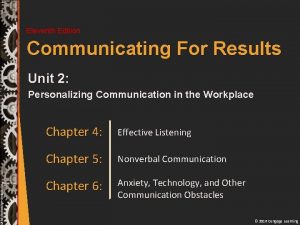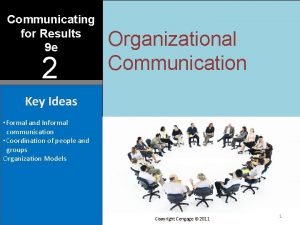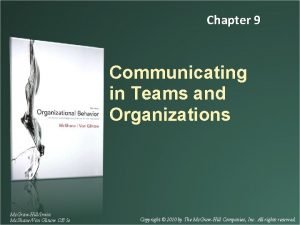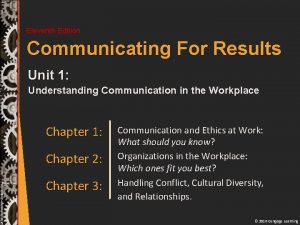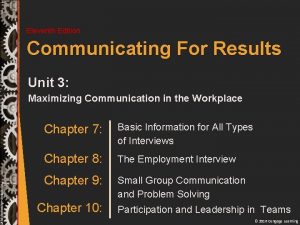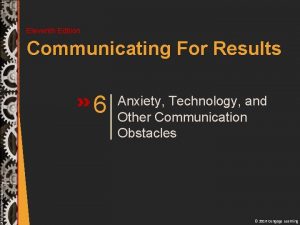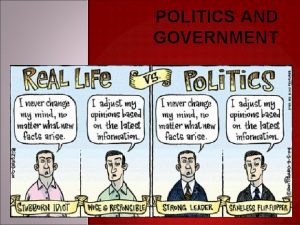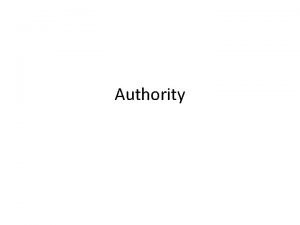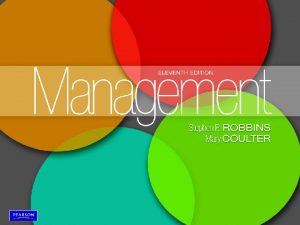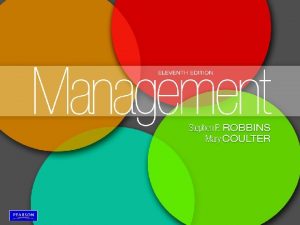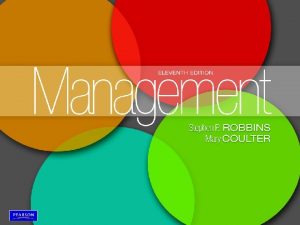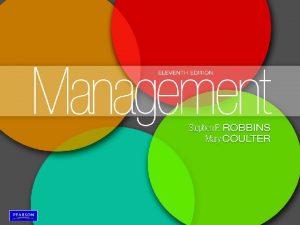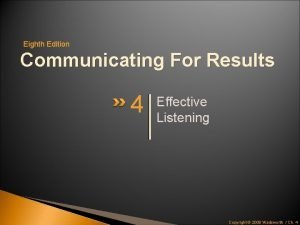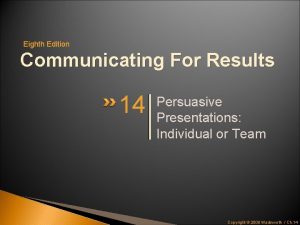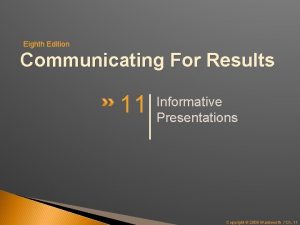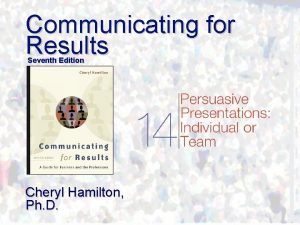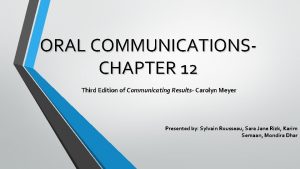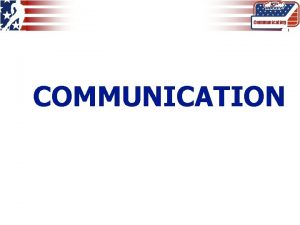Eleventh Edition Communicating For Results 10 Participation and






























- Slides: 30

Eleventh Edition Communicating For Results 10 Participation and Leadership in Teams © 2016 Cengage Learning

Amazon: Real-Life Case Hiring Practices by “Bar Raiser” q Review the real-life case. q Answer the questions for Ch. 10: (pg. 196) − Which dysfunctional behavior would be most disruptive to the Amazon team culture? − Which leadership styles would work best? − Poll your group to see which leadership style is appreciated most—would you fit in Amazon culture? © 2016 Cengage Learning

10 Really? Ann Cairns, President of International Markets at Master. Card, feels that the task of the leader is to “build mutual respect [among team members] so that you don’t create a team of mediocre people who are all happy with each other and don’t challenge each other” (Bryant, 2016, p. BU 2). Bryant, A. (2016, January 3). Ann Cairns of Master. Card: The art and science of team chemistry. The New York Times, p. BU 2. © 2016 Cengage Learning

Effective Team Participation © Phil Boorman/Age. Fotostock © 2016 Cengage Learning

Communication Skills Do you agree that these are necessary for effective team participation? q Commitment and preparation q Active listening q Open-mindedness © Phil Boorman/Age. Fotostock com Wavebreak media/Shut terstock. q Effective personality types> © 2016 Cengage Learning

“Big Five” Factors Personality factors important in successful teams. . . q Extroversion How sociable, talkative, assertive, and comfortable with interpersonal relationships you are! © Phil Boorman/Age. Fotostock © 2016 Cengage Learning

“Big Five” Factors Personality factors important in successful teams. . . q Extroversion q Agreeableness How well you get along with others by being good-natured, cooperative, forgiving, understandable, and trusting! © Phil Boorman/Age. Fotostock © 2016 Cengage Learning

“Big Five” Factors Personality factors important in successful teams. . . q Extroversion q Agreeableness q Conscientiousness How well you focus on goals in a responsible, responsible dependable, dependable persistent, persistent and achievementoriented manner! manner © Phil Boorman/Age. Fotostock © 2016 Cengage Learning

“Big Five” Factors Personality factors important in successful teams. . . q Extroversion q Agreeableness q Conscientiousness q Emotional stability How calm, calm enthusiastic, enthusiastic and secure you are (instead of tense, tense nervous, nervous depressed, depressed or insecure! insecure © Phil Boorman/Age. Fotostock © 2016 Cengage Learning

“Big Five” Factors Personality factors important in successful teams. . . q Extroversion q Agreeableness q Conscientiousness q Emotional stability q Openness to experiences The degree to which you have a broad range of interests, interests are creative, creative and willing to consider new ideas! ideas © Phil Boorman/Age. Fotostock © 2016 Cengage Learning

10 Awareness Check Big Five Personality Factors. . . See Interpretation on p. 180 or back of book. © 2016 Cengage Learning

Group Task Functions How many of the following do you use in groups? q Initiate q Elaborate q Give information q Energize q Seek information q Review q Give opinion q Record siness Monkey Bu om tterstock. c hu Images/S q Seek opinion © Phil Boorman/Age. Fotostock © 2016 Cengage Learning

Group Maintenance Functions Describe the importance of each of the following. . . q Encourage q Harmonize q Relieve tension Phovoir/Shu tterstock. c om q Gatekeep © Phil Boorman/Age. Fotostock © 2016 Cengage Learning

10 Polishing Career Skills How well do you handle functions in groups? INSTRUCTIONS: After participating in a group discussion, complete the following questionnaire indicating how often you performed each task and maintenance function. 1 = Never 2 = Once 3 = Twice 4 = A few times 5 = Several times See p. 283 for interpretation of scores. © 2016 Cengage Learning

Dysfunctional Behaviors Describe these behaviors that cause unproductive conflict in groups. . . q Blocking q Aggression q Storytelling q Recognition seeking q Special-interest pleading q Distracting q Withdrawing q Dominating ke/Corbis Florian Fran q Confessing © Phil Boorman/Age. Fotostock © 2016 Cengage Learning

Dysfunctional People Florian Franke/Corbis Ques: What are specific ways to minimize the effect of dysfunctional behaviors? Dysfunctional behaviors: See helpful hints on pg. 284. © Phil Boorman/Age. Fotostock © 2016 Cengage Learning

Approaches to Effective Team Leadership © Phil Boorman/Age. Fotostock © 2016 Cengage Learning

Trait Approach This approach to leadership involves personal traits. . . q Ambitious q Trustworthy q Motivated Problem: Can these traits be learned in a reasonable length of time? q Self-confident Digital Visi Images on/Photodi q Creative sc/Getty q Knowledgeable © Phil Boorman/Age. Fotostock Unlikely! © 2016 Cengage Learning

Function Approach This approach to leadership uses task & maintenance functions. . . Task & maintenance functions CAN BE learned in a reasonable length of time! © Phil Boorman/Age. Fotostock Yuri om tterstock. c Arcurs/Shu “Any time you perform a task or maintenance function, you are the leader for that period of time. ” dness! Thank goo © 2016 Cengage Learning

Styles Approach This three-dimension approach to leadership has three styles. . . 1. Autocratic leadership style 2. Democratic leadership style 3. Laissez-faire leadership style Time Needed 1 2 3 A = Making decision B = Developing commitment to decision C = Implementing decision © Phil Boorman/Age. Fotostock © 2016 Cengage Learning

Test Your Knowledge! In small groups, answer the following. . . 1. List some advantages and disadvantages of the authoritarian, democratic, and laissez-faire leadership styles. 2. Which style is overall the fastest? Why? 3. Under what conditions does each style work best? Leadership (3 -dimension) Styles: Discussed on pp. 287 290. © Phil Boorman/Age. Fotostock © 2016 Cengage Learning

Situational Contingency This approach to leadership depends on the situation. . . q Situation dictates leadership style q Leadership depends on: 1. Leader-follower relations (liked? ) 2. Position of power (powerful? ) i. Stockphot o. com/Sto cknroll 3. Task structure (organized? ) © Phil Boorman/Age. Fotostock © 2016 Cengage Learning

Situational Styles This approach to leadership includes the following four styles. . . q Delegating style q Participating style q Telling style © Phil Boorman/Age. Fotostock Images n/ Digital Visio etty Photodisc/G q Selling or coaching style © 2016 Cengage Learning

Transformational Approach Leaders of this approach (Charismatic leaders). . . q Inspire followers q Articulate a vision q Provide plan for attaining vision Josh Edelson Images /Getty q Mobilize commitment © Phil Boorman/Age. Fotostock Zuckerberg © 2016 Cengage Learning

Let’s Practice! Which leadership approach fits you best, complete the following: 1. 2. 3. 4. 5. 6. Pg. 286, Leadership Trait Questionnaire Pg. 283, Polishing Your Career Skills Questionnaire for task & maintenance functions. Pg. 290, Leadership Styles (Three-Dimension) Questionnaire. Pg. 291, Situational Contingency Leadership Questionnaire. Pg. 293, Situational Leadership (Styles) Questionnaire. Pg. 295, Charisma Quotient When finished: Bring to your professor: 1) Scores for each questionnaire and 2) Two paragraphs supporting which leadership approach is best for you and why. © Phil Boorman/Age. Fotostock © 2016 Cengage Learning

Leader Responsibilities © Phil Boorman/Age. Fotostock © 2016 Cengage Learning

Virtual Meetings Leader responsibilities include. . . q Select team members carefully q Avoid micro-management ty Images B Buson/Get q Provide detailed training q Encourage regular, extensive communication q Resist managing with authority © Phil Boorman/Age. Fotostock © 2016 Cengage Learning

Face-to-Face Meetings Leader responsibilities include. . . q Select place and inform members q Check that everything needed is in place q Welcome people as they arrive q Start & end meeting on time © Phil Boorman/Age. Fotostock Images ctions/lcon Letta Produ q Verify recorder is present ical/Getty q Preview & stick to agenda © 2016 Cengage Learning

Face-to-Face Meetings Continued leader responsibilities include. . . q Encourage discussion & ask skillful questions. q Perform needed task & maintenance functions. q Listen carefully q Summarize © Phil Boorman/Age. Fotostock Images ctions/lconic Letta Produ q Disseminate results al/Getty q Thank participants/audience © 2016 Cengage Learning

10 The End © 2016 Cengage Learning
 Communicating for results 11th edition
Communicating for results 11th edition Communicating for results 11th edition
Communicating for results 11th edition Management eleventh edition stephen p robbins
Management eleventh edition stephen p robbins Eleventh edition management
Eleventh edition management Management eleventh edition
Management eleventh edition Management eleventh edition stephen p robbins
Management eleventh edition stephen p robbins Communicating vs non communicating hydrocele
Communicating vs non communicating hydrocele Erd perpustakaan
Erd perpustakaan Communicating for results
Communicating for results Eleventh 5 year plan
Eleventh 5 year plan Eleventh 5 year plan
Eleventh 5 year plan Thfive
Thfive For his eleventh birthday elvis presley
For his eleventh birthday elvis presley Using mis (10th edition) 10th edition
Using mis (10th edition) 10th edition Zulily case study
Zulily case study Communicating in teams and organizations
Communicating in teams and organizations Dance is a way of knowing and communicating
Dance is a way of knowing and communicating Dance is a way of knowing and communicating
Dance is a way of knowing and communicating Kontinuitetshantering i praktiken
Kontinuitetshantering i praktiken Typiska novell drag
Typiska novell drag Tack för att ni lyssnade bild
Tack för att ni lyssnade bild Vad står k.r.å.k.a.n för
Vad står k.r.å.k.a.n för Varför kallas perioden 1918-1939 för mellankrigstiden
Varför kallas perioden 1918-1939 för mellankrigstiden En lathund för arbete med kontinuitetshantering
En lathund för arbete med kontinuitetshantering Personalliggare bygg undantag
Personalliggare bygg undantag Tidböcker
Tidböcker Sura för anatom
Sura för anatom Förklara densitet för barn
Förklara densitet för barn Datorkunskap för nybörjare
Datorkunskap för nybörjare Tack för att ni lyssnade bild
Tack för att ni lyssnade bild Debatt mall
Debatt mall
